Fuse Paper Ignitor
I wish I could say I invented fuse paper but no, it's way too clever for
me.
It was described in one of the books in my high school library indended
to prevent the reproduction of geeks like me.
Yeah, I think that book was intended to take us out of the gene pool.
For instance, there was an article was on how to make a gas explosion using
alcohol, ether, or gasoline.
An illustration was provided, where a nerdy school kid is shown igniting
some explosive gas mixture in a large glass laboratory jar. Even at
that naive age I wondered if that were a good idea.
There were no captions like: "This is
DUMB!" or "look what we got this
idiot to do..." Even I was not stupid enough to try that - I
stuck with metal cans, and was lucky to escape with all my faculties intact.
At least the kid in the book was wearing goggles.
But there was a jewel in this book, a throwaway line that I can almost
quote: "Soak paper toweling in a solution of potassium nitrate, let
it dry, and it will burn like a fuse, continuously, and without flame."
I made lots of fuse paper. It was easy. It was fun. It
did not substitute well for rolled black powder fuse, as it would not burn
through a tiny opening, nor past any point at which it was compressed. But
it burned well in open air, making large amounts of smelly smoke. It
served as a good delay fuse to let me get some distance between my body and
whatever wacky experiment I had cobbled up that day.
While preparing a moon-burner load for static testing and pondering
the non-straight path the ignitor lead must follow into and out of the motor
casing, I had a throwaway thought: wrap a strip of fuse paper around
a bare ignitor bridge wire, and have it serve as the pyrogen. Could
that work?
Tried one in open air... It worked! Made a little smoky flash.
Tried one inside a small candy grain. It worked! Bigger smokier
flash.
Tried it in two 38mm static tests - both ignited OK, one fairly quick.
Excited, I started writing this page.
Here's how:
Materials:
One two-ply paper towel, 11 by 12 inches square (wt: 3.6grams
- see note 1)
1 teaspoon (6.4g) potassium nitrate (see note 2)
1 tablespoon (15ml) hot water.
The potassium nitrate is dissolved in the hot water, the towel pressed
into the water, squeezed and kneaded until the solution is evenly distrubuted.
The wet towel is carefully unfolded, laid flat on a glass baking dish,
and placed in a warm oven to dry.
Alternatively, it could be allowed to air-dry or sun-dry, but should not
be hung up to dry. That could cause some of the liquid to migrate to
the lower side of the towel, making that side richer in KNO3, the top side
leaner.
(Note 1: I am actually using two sections of Bounty "Select-A-Size"
paper toweling, roughly equivalent to one regular-sized towel. Bounty
is one of the stronger paper towels available here - it does not tear
easily when wet, as many do.)
(Note 2: 1 tsp KNO3 makes a "rich" fuse paper, which burns rather fast.
If you wish to use this for a delay train, try 1/4 tsp instead.)
To complete the ignitor,
I cut a strip of fuse paper 1 inch wide and four inches long, wrapped
it around the head of a naked bridge wire,
and tied it with sewing thread. I have used yellow and purple thread
so far, and haven't noticed any difference. I used Scotch tape once,
and it worked too. This is a good size for 38mm motors.
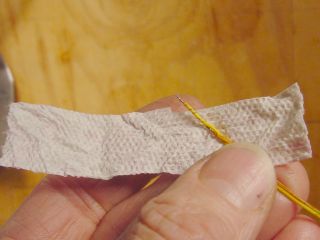
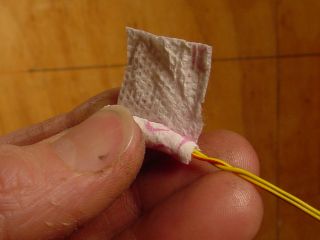
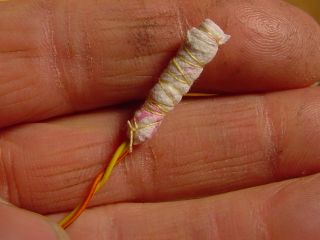
That's it! So far, these have worked just fine in several static tests and two
launches. Reliability is good, and ignition speed seems comparable to
my "standard" ignitor, which is a bare match inside a piece of masking tape
with a pinch of homebrew black powder and either Ti or Mg flakes for spice.
The only failure was when I entered klutz mode and put the ignitor in
the wrong place. A subsequent conventional ignitor failed in the same
motor, same reason.
Metal flakes could easily be included in this ignitor as well, simply by
wrapping them inside the paper.
Here: I tested one with a modest pinch of fine Ti flakes. Night
shot for effect.
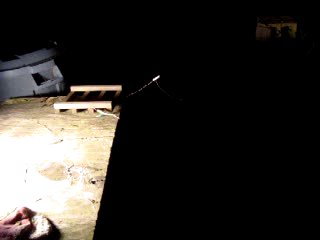
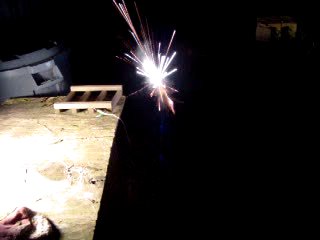
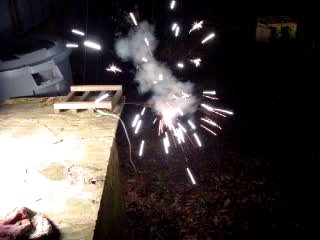
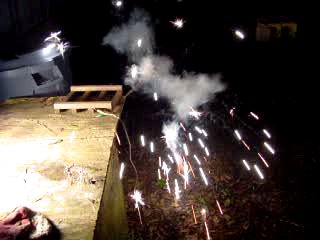
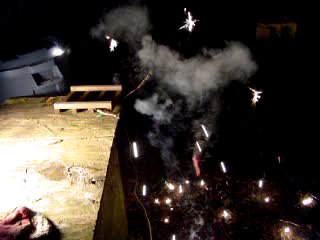
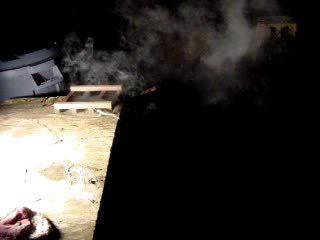
Here are videos of the two types:
Without Ti (941k .mpg)
Notice the hot globs of molten KNO3 dancing around on the pad.
Such globs burn nice holes in wood or other flammable substances.
With Ti
(1 meg .mpg)
I find that a little white-hot metal increases the reliability of my bp
ignitors. So far it has not been necessary in the fuse paper ignitors,
but I have been loading them and firing them right away, before the grains
have a chance to pick up moisture. So metal may be good insurance for
motors that are stored, since candy propellant tends to form a damp surface
which is kinda hard to ignite.
Similarly, I would be concerned about the fuse paper wicking up moisture
from a damp grain if it is stored there for any length of time. Then
again, one does not normally insert the ignitor until the last moment, right?
I am intrigued by the possibilities of this ignitor. It is so easy
that it seems there must be something wrong with it. No doubt I will
find out what that is in further testing.
Jimmy Yawn
3/29/05
rev. 4/13/05
Recrystallized Rocketry








